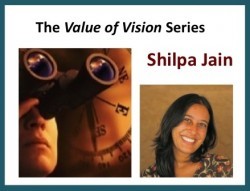 SEEing the Change
SEEing the Change
Shilpa Jain
“Is vision over-sold and over-rated? Why does vision matter in today’s world? What’s vision got to do with leadership?” When Jesse Stoner asked me to write this blog, the idea that the value of vision was even a question surprised me.
It’s like Tina Turner asking, “What’s love got to do with it?”
The answer is obvious (to me): EVERYTHING.
I have the privilege and blessing of engaging with dynamic young and intergenerational changemakers all over the world, from the US to Turkey, from India to Canada, from Jordan to Pakistan.
One of the tools I have found that serves most in healing historical divides and uniting diverse people, perspectives and experiences is vision. It’s also what sets the stage for authentic collaboration and manifestation of the world we want.
YES!, the 23-year-old organization that I direct, has a vision of thriving, just and sustainable ways of life for all. It’s a broad, beautiful call that invites young leaders, in particular, to connect with us. YES! focuses on the meeting point of personal, interpersounal and systemic change; that is, we believe that a transformation out in the world is interdependent with a transformation in ourselves and in our relationships.
To explore and experience this kind of transformation, YES! co-creates JAMs with diverse teams of social change leaders. Think of a musicians’ jam, where people bring their experiences, stories, questions, hopes, fears, dreams, struggles, inspirations, and more, into a collective container of listening, healing, learning and unlearning.
Jams operate in the spirit of co-creation and improvisation. We never know what will happen, and that is part of the magic. It’s actually what is needed in our times — because the challenges are so complex and multi-layered. As Albert Einstein once said, “You can’t solve a problem on the same level that it was created; you have to rise to the next level.” The Jams operate on this next level—by bringing together diverse people and three interdependent layers of change: individual, communal and systemic.
The results are new solutions, improved projects, vital support networks, not to mention personal growth, lifelong friendships, beautiful partnerships, and a true experience of beloved community.
We use a variety of visioning tools and processes in Jams.
We begin by asking people to write and share their own personal intentions for the Jam. We post these around us on the walls of our main meeting room, and surrounding us, they become our collective intentions for our time together. They enable us to manifest the Jam so that it meets everyone’s hopes and needs. It’s a small example of vision in action — and it works!
At the individual level, we invite the change-makers to visualize who they want to be when they look back at the end of their lives and where they want to be a year from now. For some, their vision focuses on their health and well-being; for others, on their relationships with their families; for still others, on the kind of contribution they will make through their work. The community then supports each person in translating their vision into next steps and concrete movement forward. No matter what the focus, seeing the change supports leaders in being the change.
The same holds true for the collective vision. So much of activism is focused on stopping what is wrong and fire-fighting that few change-makers get the opportunity to visualize and articulate the world they are working to create. At the Jams, we engage in a visualization of the world 25 years from now and invite people to name this vision – using words, drawings, theater, music, dance/movement, and more.
The vision, work and impact of YES!
Three vital transformations occur through the visioning process.
First, people find themselves united in their hopes and dreams. All of their experiential and work diversity comes together, and the community realizes that they share much more than they thought. Once it is seen, it can’t be unseen. The vision serves as a collective umbrella of purpose and passion.
Second, everyone finds that their work and contribution – and that of others – has value, because everything is essential for the vision to come true. So, the need to make someone’s work better or worse, or someone’s strategy more or less important, melts away, and people begin to see the interdependence of all the different approaches. Vision puts an end to competition and enables more collaboration and cross-pollination.
Third, and perhaps most significantly, the vision gives a context for the healing of historical divides, like race, class, gender, nationality, religion, sexuality, etc. Invariably, the vision includes a world that works for everyone, in which each person is respected and included, in which each culture and community has a meaningful role to play, in which border patrols are lifted and violence has ended. This vision provides a context for doing the hard work in the Jams of being honest with our grief, pain and anger — and working through it with vulnerability and love in community. It helps support the kind of listening and (un)learning that is so vital for healing. And THAT is what ultimately makes the unification sustainable for the long haul.
A North Star
I wonder if the person who told Jesse that vision was ‘over-sold and over-rated’ had mistaken vision for blueprints or strategic plans — which can become narrow or limiting over time. But, I find vision is more like a North Star; it provides guidance and hope and direction. And, for sure, now, as much as ever, we and all leaders need that — to survive AND thrive.
 Shilpa Jain is the Executive Director of YES! Previously, she was the Education and Outreach Coordinator of Other Worlds and she spent ten years with Shikshantar: The Peoples’ Institute for Rethinking Education and Development, based in Udaipur, India where she served as coordinator of the Swapathgami (Walkouts-Walkons) Network.
Shilpa Jain is the Executive Director of YES! Previously, she was the Education and Outreach Coordinator of Other Worlds and she spent ten years with Shikshantar: The Peoples’ Institute for Rethinking Education and Development, based in Udaipur, India where she served as coordinator of the Swapathgami (Walkouts-Walkons) Network.
Shilpa has facilitated transformative leadership gatherings in India, Jordan, Senegal, Lebanon, Egypt, Thailand, Canada, Peru, and the US. Her numerous publications include A Poet’s Challenge to Schooling, Reclaiming the Gift Culture, Unfolding Learning Societies, issues of Vimukt Shiksha (“Liberating Learning”) and the Swapathgami newsletter.













Fantastic article Jesse and Shilpa. Have commented elsewhere (G+) but this should be required reading for all those people trying to connect and heal – be it families, teams, organisations or countries!
Thanks for a great series and an inspirational article.
Thanks, David. Not only did I want to feature Shilpa’s thoughts on vision, I also wanted people to be aware of her amazing organization, YES! I’m so glad you appreciated it.
Loved that clip! Mutual vision change history!
Thanks shilpa and Jesse for such an excellent taste of VISION.
Khalid
Awesome post! Too often Vision is created by the marketing or communication department folks who confuse it with a tag line. I love the three part process, or layers Shilpa describes, “individual, communal and systemic”. That process with a diverse group, supported to explore Vision in multiple ways, always seems to be not only transformative for the folks involved in the process, it ripples out to resonate with others.
One of the challenges to this process is getting that diverse group into the same space. I have seen many a school and school district really embrace the idea of creating a community created Vision but have little or no success in inviting the diverse representation they need into this kind of process. I know what Peter Block would say about that 🙂 but am wondering about other ideas.
Thank you so much, David, Jesse, Khalid and Jamie for your responses and comments. Super kind! Thank you!
Jamie, I have found that a diverse convening begins with a diverse team putting together and sending out an invitation together. They are able to reach different folks, who trust them and therefore show up for them. A diverse team is also able to craft an invitation that ‘speaks’ to many different kinds of folks, because it reflects their unique voices and the special alchemy that happens when they come together. That’s one way to get the diversity from the get-go, which is really what makes a vision come alive and feel even more authentic and possible.
Hi Shilpa,
Wiser words I have not heard! I’m a huge fan of Jesse’s and of Wheatley, Block and Page and you have summed up much of their sentiments in one eloquent paragraph. I’ve now borrowed this for my blog 🙂 Thank you so much for sharing!
jamie
Thanks for your kind words, Jamie. So glad you found Shilpa’s post helpful. Hope you enjoy the rest of the series. There are wide variety of views and approaches to vision.